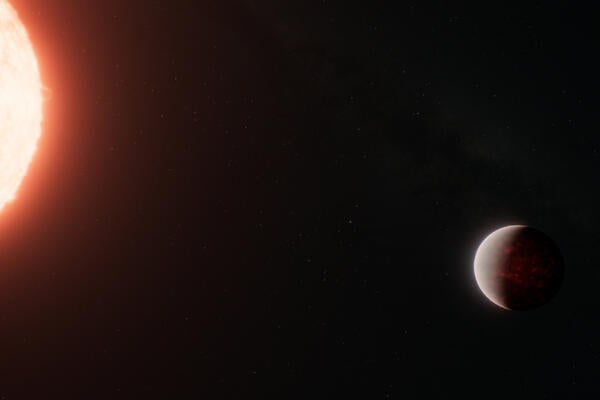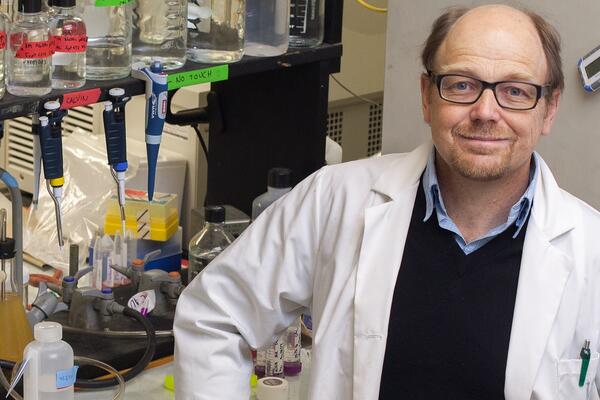
Waterloo scientists see 11 billion years into the past
The first cosmological measurements from a global collaboration bring us one step closer to solving the mystery of Dark Energy

The first cosmological measurements from a global collaboration bring us one step closer to solving the mystery of Dark Energy
By Media RelationsCanadian scientists working with the Dark Energy Spectroscopic Instrument (DESI) participated in the DESI collaboration's first-year analysis of an exciting new three-dimensional map of the universe, providing details about our cosmological past that have never been seen before.
The 3D map produced by DESI can see 11 billion years into the past, and help scientists understand how the universe has grown and evolved. This map of the cosmos uses galaxies and gas clouds as tracers of cosmic expansion throughout history and provides the most precise measurements we've ever seen of how the universe has expanded. Significant care was taken throughout all stages of data analysis, which led to the mapping of five million galaxies in unbelievable detail.
Scientists from the University of Waterloo and Perimeter Institute played an integral role in creating this new map, along with collaborators from over 70 institutions around the world. DESI is managed by the US Department of Energy's Lawrence Berkeley National Laboratory (Berkeley Lab). The Waterloo team is led by Dr. Will Percival, professor in Waterloo's Department of Physics and Astronomy and director of the Waterloo Centre for Astrophysics.

DESI has made the largest 3D map of our universe to date. Earth is at the center of this thin slice of the full map. In the magnified section, it is easy to see the underlying structure of matter in our universe. Credit: Claire Lamman/DESI collaboration.
A key component of DESI is the study of Dark Energy, which is Percival's specialty. "We have previously found convincing information that the universe is going through accelerated expansion. We call the unknown physics driving this 'Dark Energy'," said Percival, who is also an associate faculty member at the Perimeter Institute for Theoretical Physics in Waterloo. "By measuring DESI's data, we are getting a better idea of what Dark Energy could be."
The Waterloo research team has played a major role in DESI since 2018. "We observe the spectra of light from galaxies using DESI and use this to estimate the distance to them," said Alex Krolewski, a Waterloo postdoctoral fellow who works on cataloguing galaxies and their positions within that bigger picture. "In this round of data, we can see that some of the galaxies are further away and some are nearer than previous models suggested. This is giving us new insights into Dark Energy."
"This is the first year of reporting from DESI, and with four more years of data still to discover, we have only just started to see how important DESI will be to the world of cosmology," said postdoctoral fellow Enrique Paillas, who works in the core team making the measurements. "The data collected from DESI over the next few years will shed more light on the fundamental question of what is Dark Energy."
DESI is also looking to help scientists better understand neutrinos, elusive particles that are hard to detect but play a big role in the formation of the universe. When combined with observations made of the Cosmic Microwave Background, remnants of the first light that could ever travel freely across the universe, the DESI team was able to calculate the sum of the masses of the three types of neutrino particles more precisely than ever before.
Waterloo postdoctoral fellow Hanyu Zhang is working on this result. "The quality of the DESI results means that we are able to see hints about the distribution of the neutrino masses. Future DESI data should enable us to distinguish between models at a very interesting level of precision," Zhang said.
More information about this work can be found in three DESI year one cosmology and supporting papers published today.
The DESI collaboration is honoured to be permitted to conduct scientific research on Iolkam Du'ag (Kitt Peak), a mountain with particular significance to the Tohono O'odham Nation.
The University of Waterloo acknowledges that much of our work takes place on the traditional territory of the Neutral, Anishinaabeg, and Haudenosaunee peoples. Our main campus is situated on the Haldimand Tract, the land granted to the Six Nations that includes six miles on each side of the Grand River. Our active work toward reconciliation takes place across our campuses through research, learning, teaching, and community building, and is coordinated within the Office of Indigenous Relations.

Read more
Here are the people and events behind some of this year’s most compelling Waterloo stories

Read more
Discovery of a thick atmosphere on a lava world reshapes our understanding of rocky exoplanets

Dr. Brian Dixon, professor of biology at the University of Waterloo says there is a link between cold weather and getting sick. (University of Waterloo)
Read more
Waterloo researcher shares why we get sick when the mercury dips
The University of Waterloo acknowledges that much of our work takes place on the traditional territory of the Neutral, Anishinaabeg, and Haudenosaunee peoples. Our main campus is situated on the Haldimand Tract, the land granted to the Six Nations that includes six miles on each side of the Grand River. Our active work toward reconciliation takes place across our campuses through research, learning, teaching, and community building, and is co-ordinated within the Office of Indigenous Relations.